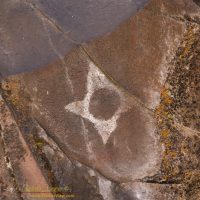Among the petroglyphs at Horsethief Lake is one that has always caused me to wonder. Of course the site is home to the famous Tsagaglalal or She-Who-Watches image. This is not the one I refer to, rather a somewhat smaller and usually overlooked image.

To my eye the image is clearly that of the solar corona surrounding the black shadow of the Moon against the Sun. The image is all the more striking to me personally… In 1979 I witnessed a total solar eclipse, my first, just a short distance from here, from the bluffs above Maryhill.
But which eclipse would the artist have recorded? We can calculate eclipses of the past with good precision… A total eclipse passed over the mouth of the Columbia and central Washington in 1860, probably a little too late for the petroglyph in question. Another passed through central Oregon in 1742, missing the area by a short distance. You have to go back to 1618 to see a total solar eclipse along the river, right over where this petroglyph is located.

Occurring in the middle of summer, on July 21st, the weather would have most likely been clear for this midday event. Indeed, Horsethief is just a couple miles from the eclipse centerline. The area was the site of dozens of fishing camps where thousands came from across the region to fish the summer salmon runs. July would have been the height of the season for those fishing the river. The event would have been a looming memory in the mind of everyone who witnessed it.
Would a painted pictograph like this one survive for four centuries? It appears so. Researchers have found that even the painted images can have a lifespan measured in centuries in a good location. The pigments used seep into the porous rock, while minerals leached from the rock tend to coat and protect the image. Certainly I have seen no fading of the images in the decades I have known the Horsethief petroglyphs.
Interpreting any image like this is fraught with hazard… Is it possible that this design is merely a random geometric figure? Sure. On the other hand there are very few random linear or geometric images at Horsethief, almost all are of specific things. Could it be something else? Sure. I can not think of anything specific. I am pretty sure this image represents a total solar eclipse. I could be wrong, there is no way to truly know what that ancient artist was attempting to portray.
Across the region some similar images appear at a number of sites, some calling the four pointed figure a Yakima Star. These images are both painted and pecked, usually with a central dot. I have seen no interpretation of these images, no meanings guessed, they could all be a depiction of a solar eclipse, or be something else entirely. The confluence of the Columbia, Deschutes, and John Day rivers was a central point of cultures from the entire region. An eclipse occurring here would have been witnessed by thousands of people who had come to the river for the summer salmon runs.
There is another petroglyph proposed as a possible solar eclipse representation. It is located near the Una Vida ruins at Chaco Canyon, New Mexico. The ancient Puebloan peoples were accomplished skywatchers with other astronomical petroglyphs and alignments in their buildings.
Another possible solar eclipse petroglyph is found near Gila Bend. I find this one a little more convincing, in the depiction, and as it located in an area occupied by peoples who had good knowledge of the sky.
In a very short while another total solar eclipse will sweep across Oregon, potentially witnessed by millions of people. When I observe the eclipse I expect to be reminded of an obscure bit of art on a rock face overlooking the Columbia river. I will think of that ancient artist who may have witnessed and recorded an eclipse centuries ago.

